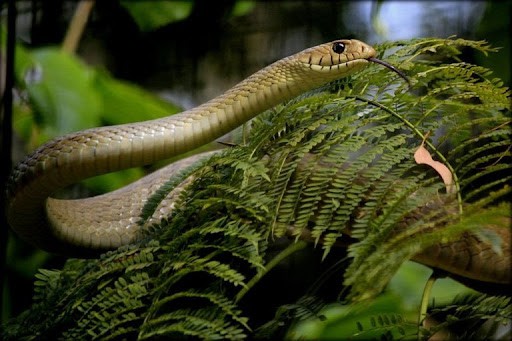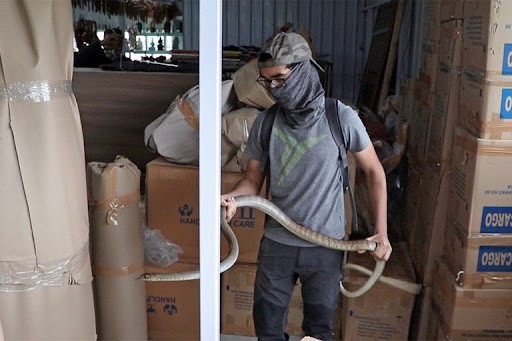“Sun’s out, snakes out!” exclaimed Shuayb Ahmed, and Yatin Kalki as they jumped to action. Ahmed, an independent snake rescuer, had received a frantic call from a woman who spotted a snake – claimed to be a juvenile spectacled cobra – in her house in Bengaluru. The team quickly geared up for the ‘rescue’ – an empty pillow case, a snake hook, a hollow pipe, and a flashlight. “Timeliness is key,” Ahmed said, as he hurried to the vehicle.
On reaching the house, Kalki went about locating the snake, while Ahmed checked for access points from where the snake possibly came. He noticed that the houses next door had open land with unattended sacks stacked and garbage overflowing – that made for a great place for snakes to come in search of prey such as rodents and frogs. Ahmed advised the neighbours on keeping the space clean to avoid such instances.
Once the snake was spotted, Kalki calmly bagged it, and Ahmed finished the legal formalities and documentation of the rescue. The entire process took a total of 20 minutes.
On any given day, in the bustling metro of Karnataka, independent snake rescuers like Ahmed as well as the wildlife rescue cell of Bengaluru city’s municipal corporation receive eight to ten calls for snake rescues, each. On average, the southern state records 2,400 human deaths from snake bites in a year.

With Bengaluru’s growth, there has been a considerable change in the urban snake population and diversity as well, though not enough research is available for a definitive understanding. The first official account of snake species present in Bengaluru is a century old. The checklist was recorded by Edward Nicholson in the year 1874 and this list had 18 species of snakes including venomous and non-venomous snakes. Since then, there have been land-use changes, taxonomic revisions, and fluctuating reptile populations but the count of snakes is unclear in the region.
Now, as per a recent study, the number of snake species found in the Bengaluru Urban District stands at 33 as of 2020. This includes the presence of the ‘Big Four’ – Russell’s viper (Daboia russelii), saw-scaled viper (Echis carinatus), Indian or spectacled cobra (Naja naja), and common krait (Bungarus caeruleus). This study, which combines data from snake rescues, visual encounter surveys, and other reliable records to generate a checklist, also reveals that there has been a complete shuffle in the abundance of different species of snakes as opposed to a century ago.
Kalki, one of the primary researchers of the latest study, said, compared to the earlier checklist by Nicholson, there has been a considerable decline in numbers from different species of snakes – while the population of some previously common species has reduced, that of the Big 4 has increased. Spectacled cobra and Russell’s viper are now more common in the city. These two snakes also happen to be responsible for the most number of snakebite deaths in the state. Previously common species such as the common cat snake, banded racer, Indian wolf snake, and buff-striped keelback have become uncommon to spot.
“This does not indicate that new species of snakes have moved to the city. It suggests that survey efforts and taxonomic changes have increased,“ explains Kalki. We should also look at the way Bengaluru as a city has grown. There have been considerable land-use changes associated with rapid urbanisation, agricultural intensification, and geographical expansion of the city over the last 150 years. This has definitely favoured the growth in numbers of certain species of snakes, while adversely affecting remaining species of snakes.” he said.
Read more: Not just Lalbagh, your small neighbourhood park too can protect Bengaluru’s biodiversity
A day in the life
In the two days that Mongabay-India followed Shuayb and Kalki on their rescue calls, a total of seven snakes from various locations across Bengaluru were rescued. Of these, four were spectacled cobra and three were rat snakes. The days started early and stretched till late hours in the night. They involved strenuous and challenging situations where the rescuers took up various roles during a snake rescue – from the actual rescue of the snake to educating households on cleaning up spaces to avoid attracting snakes.
Not all the rescues were of the same nature. One of the rescues was for over four hours long and was physically daunting. It was a painstaking job of moving stacks of wood, pipes, and gunny bags of flour from a dark shed that had a large spectacled cobra trapped inside. The rescuers had to be careful so as to not harm the already agitated snake, as well as not risk their own lives any further.
At a different rescue, Kalki had to deal with a man in an inebriated condition while trying to safely rescue a large spectacled cobra on the main road. The man kept tugging at Kalki’s hand while he was trying to bag the snake. A large noisy crowd also started gathering around making it much more difficult to ensure everyone’s safety. Usually, controlling the crowd is very important and a tougher task than actually rescuing a snake.

Read more: Biodiversity loss from mega real estate projects: What is missing, what can be done?
Rapid urbanisation and what it means for urban snakes
In the past 147 years, Bengaluru went from being the ‘Garden City’ of India to being known as the ‘Silicon Valley’ of Asia.
At different points through the city’s rich history, a surge of immigrants settled in the city and brought various developmental projects and establishments with them. By the 1950s, Kempegowda’s garden city had close to a million people living there who depended on agriculture, mining, trade, and construction work. By the 1980s, leading R&D laboratories, academic institutions, and public sector-focused enterprises set up shop in Bengaluru. Many of the city’s well-known lakes and tanks vanished quickly to accommodate infrastructure for this sudden surge of population.
By the 2000s, the city soon became the hub of the IT industry, and the population grew to a little over five million residents. In just two more decades, by 2020, nearly 12 million people live in the city. With a 38% increase in population between 1991 and 2001, Bengaluru had a boom in real estate as a result of the influx of new residents. The city exploded in every direction, water bodies shrunk or completely disappeared, so did the green cover in and around this new metropolitan city.
Saagar Tulshan, an architect who specialises in sustainable designs, says, “A city is a complex organism with multiple layers, where a great public place is a balance between the built and the unbuilt empty spaces of the city. ”When a city is being developed, there are certain evaluations in place to see if said place has adequate resources and capacity to sustain growth and livelihood. If not planned well, this ends up disturbing the local ecosystem.

Tulshan says, “Policy making is usually driven by a commercial purpose rather than sustainability. Although Bengaluru was established on a high point on the Deccan plateau, the city has been witnessing flash floods in the past few years. This generally happens when the infrastructure within the city such as storm water drain system, garbage disposal system, etc. is poorly maintained or hasn’t been planned well. Another reason for the flooding is the rapid disappearance of lakes from the city, on whose beds high rise concrete structures have been constructed.”
Due to this unplanned rapid expansion of human settlements in Bengaluru, it has set off a chain reaction in the ecosystem of the smaller urban wildlife of the city.
With most of the land covered in cement, tar, plinth, green patches have shrunken and have created isolated green pockets in the city. Often, these patches are separated by roads, infrastructure, residential areas, trapping the snakes within these green pockets. The snakes are thus forced to venture out in search of food or to mate. Due to this, human and snake interactions have increased in the city.
Kalki says, “Incidentally, the main diet of the cobra, Russell’s viper, and the rat snake consists of rodents, and toads which flourish around human settlements. With abundant availability of food and safe shelter in storm water drain systems in the city, these three snakes are the most rescued snakes from people’s homes in Bengaluru.”
Ahmed, a snake rescuer, from Bengaluru says, “We usually rescue a lot of baby cobras or rat snakes from people’s homes during the monsoon season. The hatching period of the snakes coincides with Bengaluru’s monsoon season. With the city flooding every season, there has been a rise in incidents of snakes showing up in people’s homes.”
Better spaces for coexistence
Kalki and Tulshan both stress that wildlife buffers for the movement of urban wildlife such as snakes amongst other animals should be accounted for during urban planning and development.
Tulshan suggests, “We need to have passages to allow wildlife to move freely without them being pushed or stranded within isolated green scattered pockets. The city’s development of open spaces should be independent of private interests of authorities and businesses. We should try to redevelop existing spaces sustainably rather than expanding aimlessly. Despite the existence of bylaws, we need laws to take into account local wildlife in micro-ecosystems. We should also create a better garbage disposal system. If our surroundings are clean, we can avoid rodentsRegular maintenance and upkeep of storm water drain also keeps floods from happening.”
Kalki adds, “Equip citizens with information and knowledge about their ecosystem, especially one where wild animals such as snakes exist. They need to be able to identify at least the most common snakes and differentiate between the venomous and non-venomous ones. I’ve noticed children are quick to learn and pick up on the idea of coexisting safely. Educating and awareness is important.”
[This article was originally published in Mongabay India.]